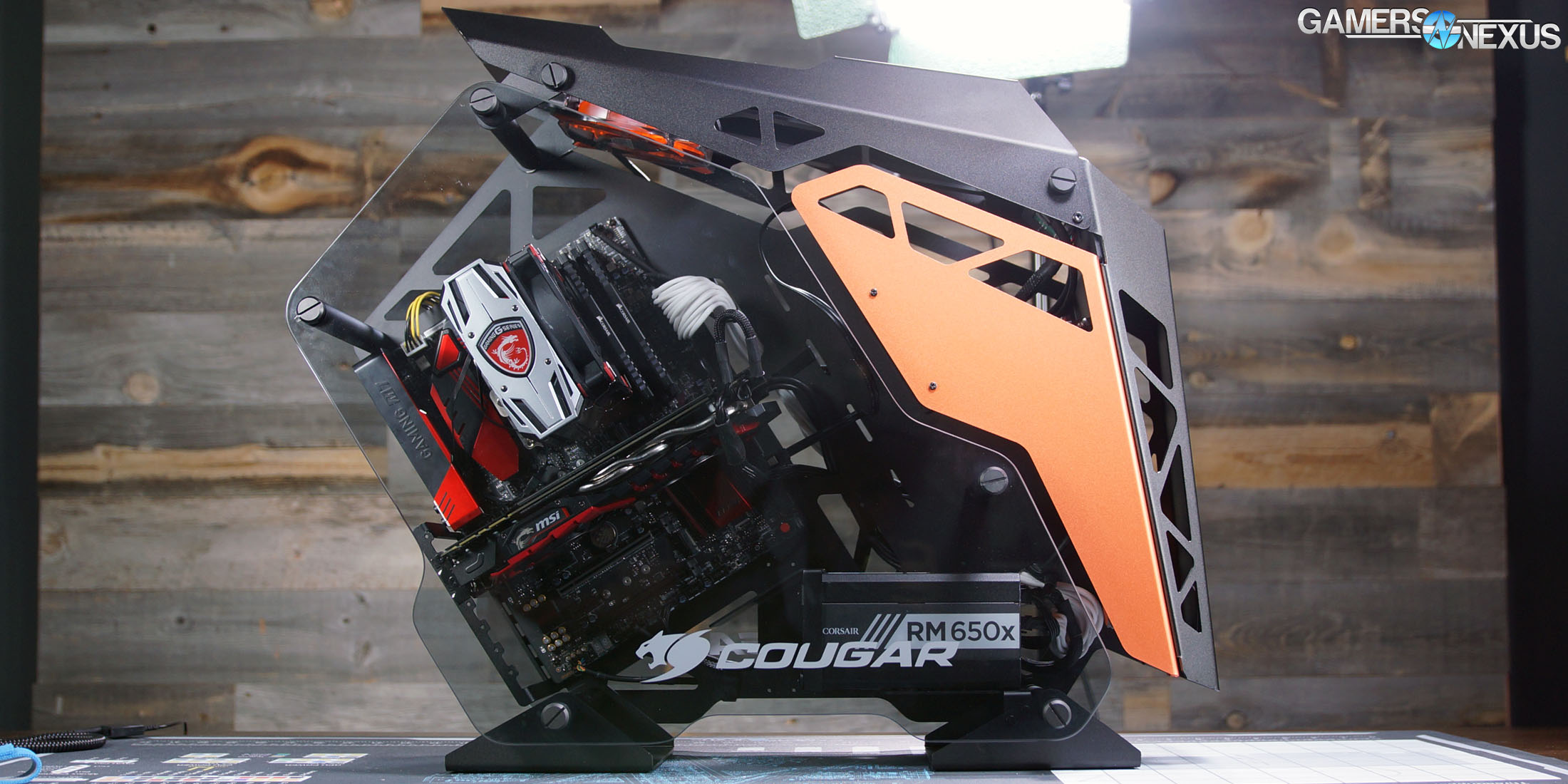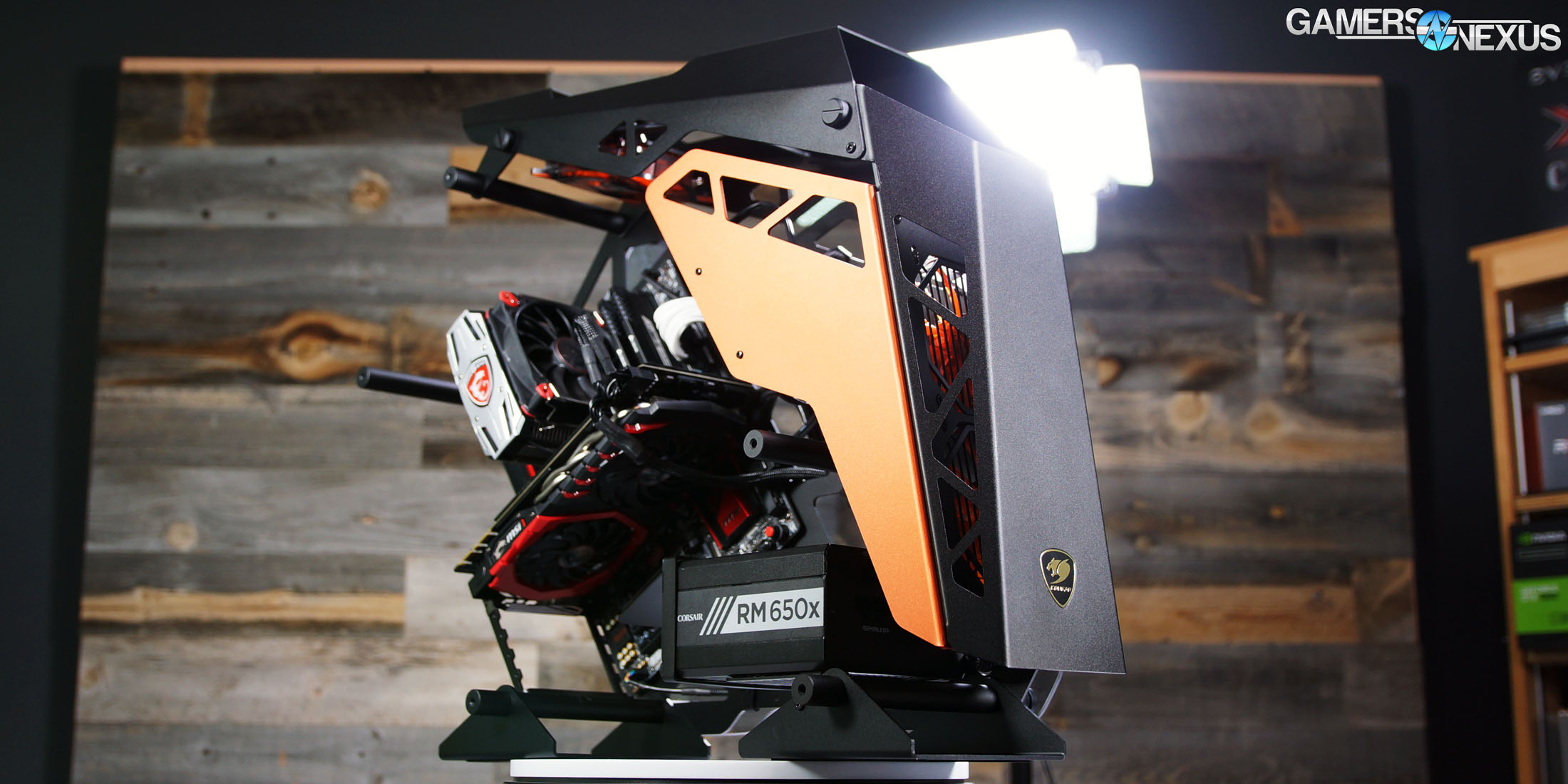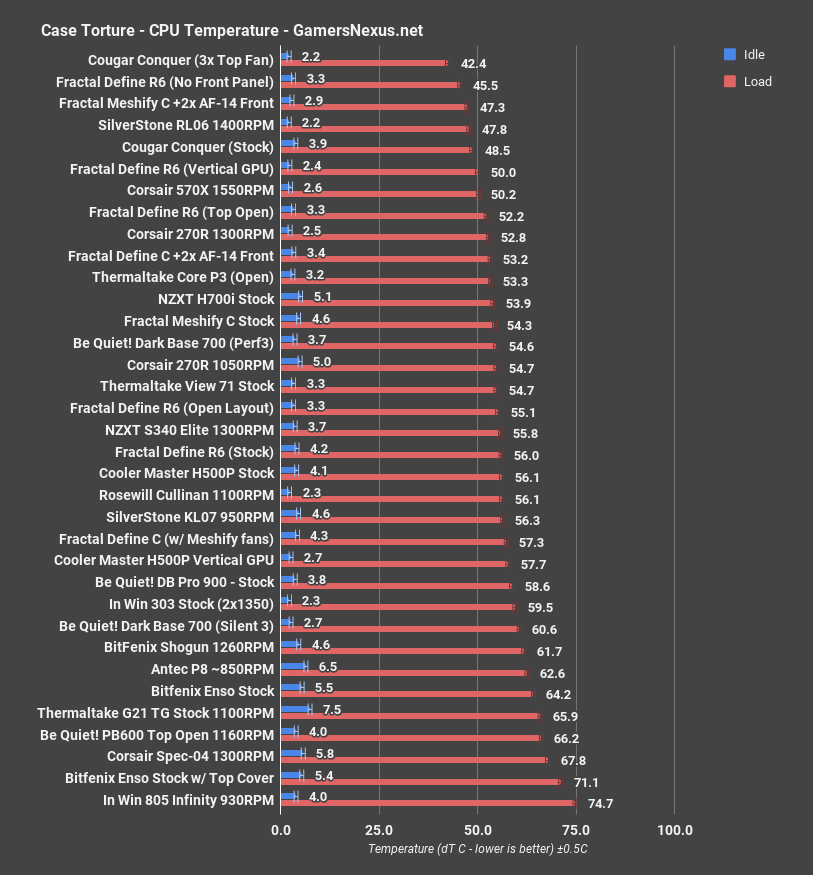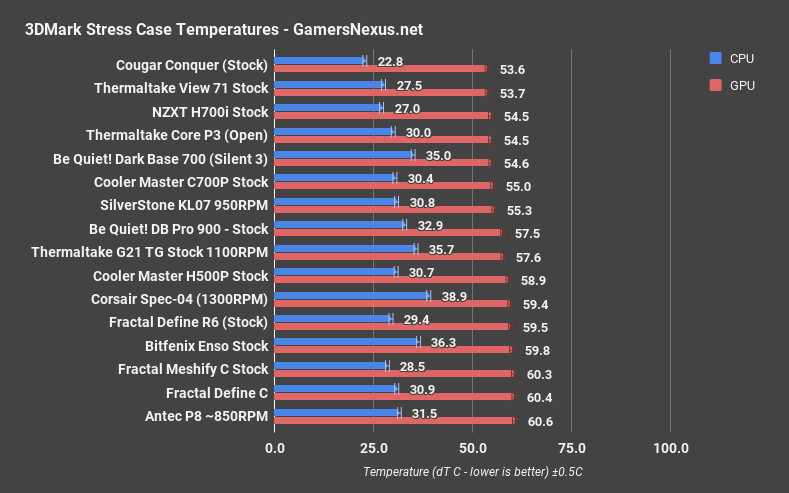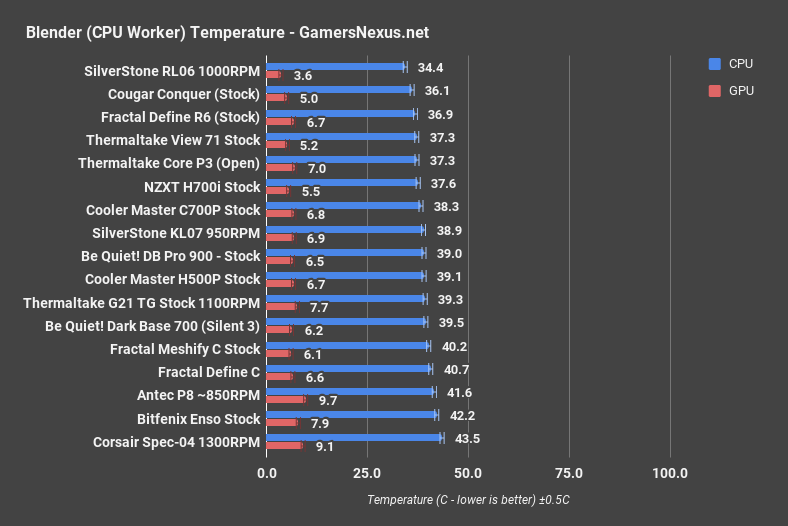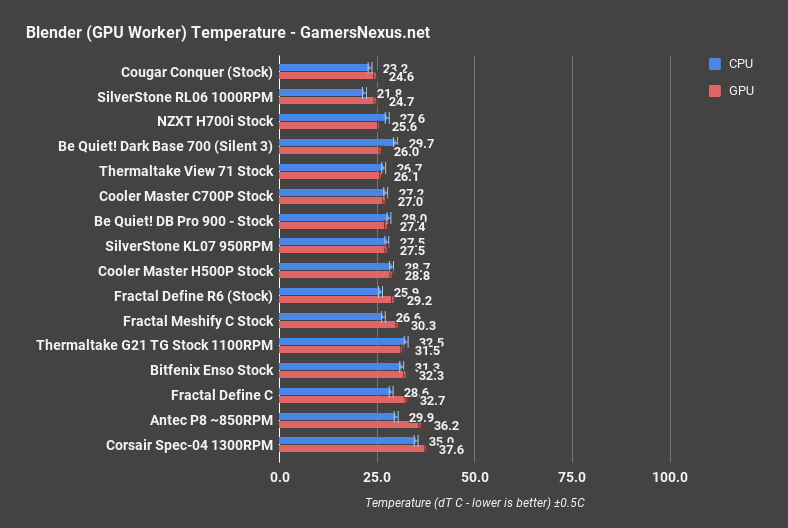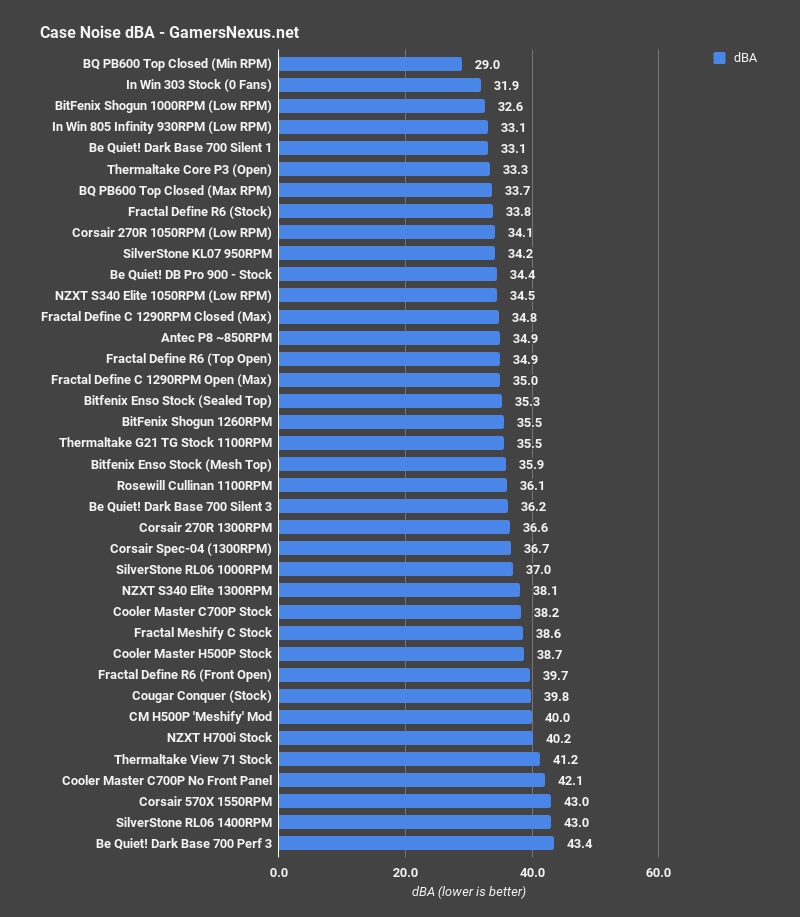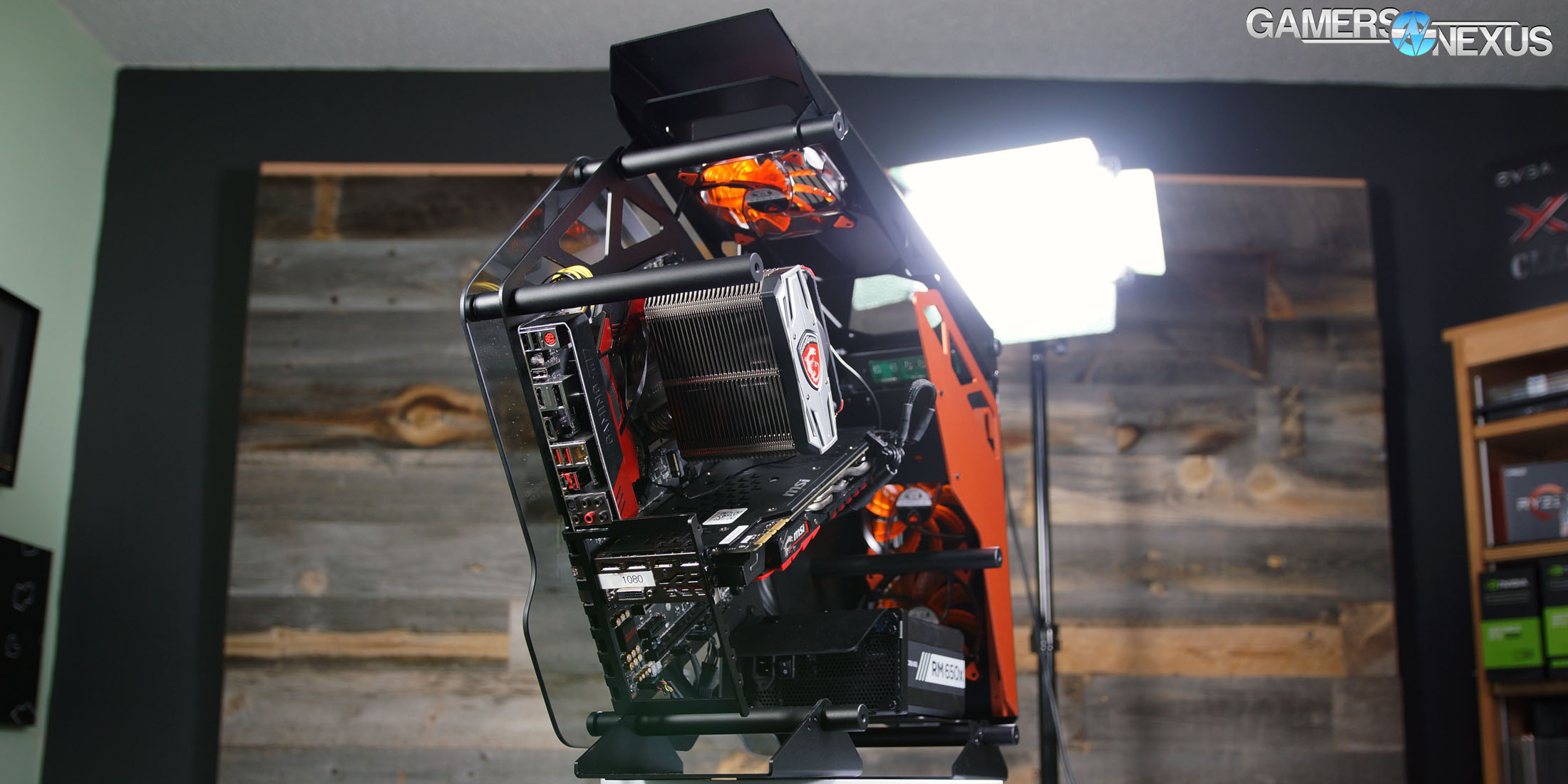The Cougar Conquer is an open-air case with a unique design that’s already attracted a lot of attention. We’ve reported on Cougar products in the past and reviewed their budget 200K keyboard back in 2015, but this is the first hands-on experience we’ve had with one of their enclosures. Cougar gets some points by default for managing to ship a glass-panelled case from Asia without anything shattering, unlike another case we received (review coming soon).
The Conquer is a huge case. It’s easy to underestimate its size in pictures because of its unusual shape, but it’s large enough to easily fit a full ATX board at a diagonal, making it both taller and wider than standard cases. The vast majority of the chassis is constructed from 5mm thick aluminum and both sides are tempered glass, making it much heavier than the skeletal frame implies. It’s technically an open air chassis, but with a case-like frame, providing mounting points for several fans.
Cougar Conquer Case Specs
Model Name | CONQUER | ||
CASE FORM FACTOR | Mid-Tower | ||
Material | Aluminum Alloy | ||
Dimension (WxHxD) | 255 x 580 x 685 (mm) 10.03 x 22.83 x 26.96 (Inch) | ||
Motherboard Support | Mini ITX / MicroATX / ATX | ||
3.5" Drive Bay | 3 max. | ||
2.5" Drive Bay | 4 max. | ||
I/O Panel | USB3.0 x 2 Mic x 1 , Audio x 1 | ||
Cooling fan support | Front | 120 mm x 2 | |
Top | 120 mm x 3 | ||
Water cooling support | Front | 240 mm | |
Top | 360 mm | ||
Fan Pre-installed | COUGAR CFD 120mm LED fan x 3 | ||
Cable Management | Yes | ||
Expansion slots | 7 | ||
Max. Graphic Cards Length | 350 (mm) / 13.77 (Inch) | ||
Max. CPU Cooler Height | 190 (mm) / 7.48 (Inch) | ||
Max. PSU Length | 220 (mm) / 8.66 (Inch) | ||
Tempered glass side panel | Both sides 5mm thick | ||
MSRP | $300 | ||
The case’s appearance is a large part of what will make users love or hate it. The translucent orange fans included with our review sample were lit by red LEDs (not the most pleasant combination), but otherwise it looked just as good as the ads.
The Conquer does fit in visually with the rest of Cougar’s product line, but it also bears a close resemblance to the Raidmax X-08, to the extent that it seems like they’re coming out of the same factory. Apparently Cougar is also fully aware of this and have been extremely snarky about it, but it’s unclear what’s happening here, whether Raidmax and their supplier genuinely ripped off an original Cougar design or if an OEM like Jonsbo is simply double-dipping with their tooling. The components are so visibly identical that the latter seems more likely, which would make it more a matter of course rather than something underhanded. We haven’t asked either company directly what’s going on--Cougar’s design has been available longer, but frankly, it doesn’t matter (to the consumer).
Cougar provided this statement to GamersNexus on the Raidmax situation:
We at COUGAR value creativity and originality as one of the driving forces of the whole electronic entertainment sector. One of the products that best exemplifies our commitment to constant improvement and breaking boundaries is our CONQUER case. Using a new, patented design, we wanted to explore uncharted territory in gaming PC case design using unique aesthetic elements that set it apart from the existing cases on the market.
It has become known to us that a products that imitate to an unreasonably extent CONQUER’s design and aesthetics have recently reached the market. In view of this situation, we want to reassert that:
1) Conquer is the first case using this popular design style. This is proven both by its appearance in several trade shows and by its date of arrival to the market.
2) Conquer is a patented design.
3) COUGAR reserves the right to decide at any time whether to pursue legal action against those brands and companies that design, produce or sell counterfeit products or any product whose design, appearance or functionality infringes in any way COUGAR’s legal rights.
4) COUGAR remarks that Conquer’s quality of design and materials is first rate, and recommends paying attention to this area when purchasing a case with a rich, elaborate design such as Conquer.
Building the case is straightforward if the instructions are followed and no parts are missing. Construction is solid. The body feels a little wobbly during installation without the added support and balancing from the glass panels, but once they’re in place the case can be safely picked up and moved by pretty much anything except the PSU and PCIe brackets. The brackets do their jobs fine, but they aren’t as heavily reinforced as the rest of the case. The glass side panels feel somewhat token, given that the case is basically open to the elements, but they must be installed for the case to be fully stable. The feet are especially wide and firmly locked into the case and both glass panels. The top of the case is a hinged lid that opens to allow fan installation and removal; hinging this lid constantly during building and rebuilding the case caused some very minor wear on case coating at the corners, but nothing noticeable.
Good-looking cable management is a real nightmare because of the dual glass side panels--there are plenty of cutouts available for strapping cables to, but none that easily make things look tidy. The power supply is mounted towards the front of the case, so cables need to stretch a little farther than usual, especially the 8 pin CPU connector.
The chassis is completely stripped down, and what you see is what you get. There’s a mounting plate for two SSDs, places to install up to 5 fans (3 included), and that’s about all there is other than a motherboard tray. Even the front I/O only includes two USB ports. It fits with the sports car aesthetic: fancy looking and high performance, but not really practical for getting work done. This Conquer doesn’t include the kind of amenities that might be expected from a more traditional high-end case, like LEDs or fan controllers or Qi chargers--or indeed anything at all other than some slabs of aluminum and glass. Whether that’s a benefit or a drawback is up to the consumer.
Case Testing Methodology
We tested using our new Skylake case test bench, detailed in the table below. This particular configuration is brand new with the launch of the 570X & 270R. Results on this test platform cannot be compared to previous case benchmark results, as the platform has completely changed.
Conducting thermal tests requires careful measurement of temperatures in the surrounding environment. We control for ambient by constantly measuring temperatures with thermocouples and laser readers. We then produce charts using a Delta T(emperature) over Ambient value. This value subtracts the thermo-logged ambient value from the measured diode temperatures, producing a delta report of thermals. AIDA64 is used for logging thermals of silicon components, including the GPU diode.
All case fans are manually configured to their maximum throughput using BIOS, then we configure to an RPM closer to 1050 for a universal "quiet" testing. If a fan controller is present, we opt-in and test on multiple settings. This forces testing of case fan performance in addition to the case's air channeling and airstream design. This also ensures minimal variance when testing, as automatically controlled fan speeds can reduce reliability of benchmarking. The CPU fan is set to 1100RPM (constant) for consistency, and the CPU is overclocked to 4.4GHz with a vCore of 1.272V (constant). C-States and power saving states are disabled.
| Component | Courtesy Of | Price | |
| Video Card | MSI GTX 1080 Gaming X (OC Mode) | MSI | $640 |
| CPU | Intel i7-6700K @ 4.4GHz | GamersNexus | $300 |
| CPU Cooler | MSI Core Frozr L | MSI | TBD |
| Motherboard | MSI Z170A Gaming M7 | MSI | $180 |
| Memory | Corsair Vengeance LED 32GB 3200MHz | Corsair | $200 |
| SSD | Samsung 850 EVO 120GB | Samsung | N/A |
| PSU | Corsair RM650x | Corsair | $100 |
| Case | This is what we're testing! | - | - |
The video card is configured to run at 55% fan speed at all times.
Prior to load testing, we collect idle temperature results for ten minutes to determine the unloaded cooling performance of a case's fans and air channels. Thermal benchmarking is conducted for 1400 seconds (23 minutes), a period we've determined sufficient for achieving equilibrium. The over-time data is aggregated and will occasionally be compiled into charts, if interesting or relevant. The equilibrium performance is averaged to create the below charts.
Load testing is conducted using Prime95 LFFTs and Kombustor “FurMark” stress testing simultaneously. Testing is completely automated using in-house scripting, and executes with perfect accuracy on every run.
We recently validated our test methodology using a thermal chamber, finding our approach to be nearly perfectly accurate. Learn more here.
For extra tests, we removed the front panel (not just the door), mounted the GPU vertically, opened the top ModuVent, and reconfigured to the “Open Layout.” Removing the front panel has become one of our regular tests, as it provides an absolute best case scenario for airflow that other results can be compared against.
Cougar Conquer Thermals & Noise
The Conquer would probably still be usable even if it didn’t include any fans at all, and would rank around where the Core P3 falls, but it does include three. We installed them according to the manual, which shows two intake fans at the front of the case and one intake at the top pointing down towards the CPU cooler. We wouldn’t always choose top intake, primarily for dust reasons, but the angle of the motherboard means that it’s the most practical way to push air into our CPU heatsink. For additional testing, we put all three stock fans in the top intake slots, since the two front intake fans are fairly far away from the actual system and possibly limited in their effectiveness, as the air just sort of diffuses across the entire chassis, and then finds the nearest hole to exit -- and there are plenty. The active cooling and big open holes combined with the lack of filters makes the Conquer (potentially) dusty, even more so than passively cooled open air cases.
Cougar Conquer CPU Torture Temperature
Focusing first on the stock Cougar Conquer configuration versus our top 3 intake setup, CPU temperature was 48.5 degrees Celsius over ambient when under a torture workload, and 42.4 degrees with all three fans at the top of the case blowing down into the CPU cooler. The top intake position is in a great spot to help CPU temperatures, and the more fans, the better. The stock top intake fan is placed directly below the cutout in the top panel of the Cougar, removing any barriers to airflow.
Comparing versus other cases, 48.5C is a lower CPU temperature than any other stock case we’ve tested, except the Silverstone RL06, and 42.4C is lower than anything on the chart altogether. The Conquer has the cooling advantages of the Core P3, but doesn’t rely solely on passive cooling to pump heat out of the case--although it could. The RL06 maintains its lead because of the huge volume of air pumped in a straight line through the case, and is only outperformed when three fans are positioned inches from the CPU intake. Most other cases we’ve tested try to balance airflow with noise suppression or visual style, and these two are clearly outliers from that norm.
Cougar Conquer - GPU Torture
GPU temperature was 50.9C in the stock configuration, and 53.2C with all fans at the top of the case. The top intake fans aim air exclusively over the backplate, while the stock configuration with two front intake fans directs air into the GPU cooler directly. The distance from the front of the case to the GPU lessens their effectiveness somewhat, but the temperature reduction is measurable. One subtle but important feature of the Conquer is that, although the PSU is mounted at the bottom of the case with no shroud, an angled aluminum shield directs its exhaust downwards and away from the GPU fans, making it easier to keep cool.
50.9C is an unusually low GPU temperature, among the best on our chart. Unlike the CPU temperatures, this has relatively little to do with active cooling: even without the benefit of fans directed into the cooler, 53.2 is still a respectable score. The biggest contributor to GPU cooling is the fact that the case has no bottom to block out cool air, and no sealed top to keep hot air in. The GPU’s heat is able to naturally find pathways out of the case, keeping it cool over long uptimes.
Cougar Conquer - 3DMark Firestrike
The 3DMark Firestrike Extreme stress test lasts longer than our torture test and typically results in a higher average GPU temperature. The Conquer managed 53.6C, just slightly better than the previous champion, the View 71 TG. We haven’t tested every case with Firestrike, but it’s safe to say that the Conquer consistently allows good GPU cooling. That’s what you get with open air.
Cougar Conquer - Blender CPU + GPU
At 36.1C dT, the Conquer had better CPU cooling during the Blender CPU render than most other cases tested, but the RL06 keeps the crown for now. Rendering on the GPU averaged a GPU temperature of 24.6C; it (barely) beat the RL06 here, making it the new leader. Both of these scores are extremely good, but the Conquer is still impractical for business use because of the lack of HDD space and lack of filtration, not to mention the size and the price. It could also be impractical for pet owners. For streamers or YouTubers that want a PC both for show and for production, though, the Conquer could be a good fit.
Cougar Conquer - Noise
As expected, the Conquer is a noisy case with three 120mm fans at full speed and nothing to silence them. 39.8dBA is similar to the Cooler Master H500P, and scores between other well-ventilated cases like the Fractal Meshify C and Thermaltake View 71. Given the cooling performance, though, there’s no reason to run the fans at full speed or even to install all three fans.
Conclusion: Cougar Conquer Review
The Cougar Conquer costs more than $300 from most retailers, which means price/performance comparisons are out the window--there’s no way the Conquer can compete with any $60 case by that metric. This isn’t a case for someone who cares about how much it costs. In the realm of flashy, open-air, and windowed cases, Thermaltake’s View 71 and Core P3 cases accomplish the same thing for less money. We already gave this speech in the Dark Base Pro 900 review, and the Pro 900 costs at least $50 less than the Conquer. Really, it comes down to a personal preference for the way the Conquer specifically looks, which is where it faces competition from the strangely similar Raidmax X-08, which Cougar indirectly alleges to be a copier. The X-08 doesn’t seem to be available from major retailers right now, but if it’s cheaper there’s no reason not to seek it out, other than a deep respect for intellectual property laws.
Performance is great, with the caveat that the $75 RL06 does just as well--pure performance doesn’t need to be expensive. The cooling is overkill, but it does mean users could choose to run the case fans at extremely low speeds to offset the noisiness of an open-air case. The only obvious concern with the case itself is dust, since unfiltered air is pushed actively through the enclosure. The Cougar Conquer is no bargain, but it does look unique and can be safely relied on to cool a system.
This is something you buy for its looks. If you like the looks, well, there’s not much for an alternative.
Editorial, Testing: Patrick Lathan
Host, Test Lead: Steve Burke
Video: Andrew Coleman
